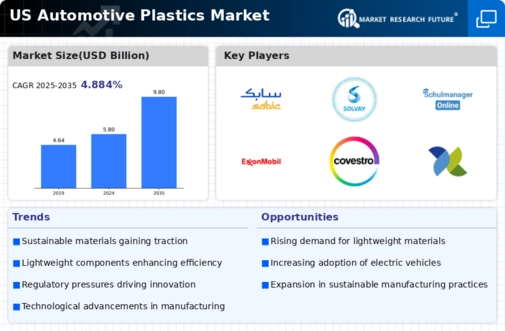The automotive plastics market is currently characterized by a dynamic competitive landscape, driven by innovation, sustainability, and technological advancements. Key players such as BASF (US), DuPont (US), and Covestro (US) are actively shaping the market through strategic initiatives aimed at enhancing their operational capabilities and market presence. BASF (US) focuses on developing advanced materials that meet the evolving demands of the automotive sector, particularly in lightweighting and sustainability. Meanwhile, DuPont (US) emphasizes innovation in polymer technologies, aiming to provide high-performance solutions that cater to the needs of electric and autonomous vehicles. Covestro (US) is also positioning itself as a leader in sustainable materials, investing in circular economy initiatives that align with the industry's shift towards eco-friendly practices. Collectively, these strategies contribute to a competitive environment that prioritizes technological advancement and sustainability.
In terms of business tactics, companies are increasingly localizing manufacturing and optimizing supply chains to enhance efficiency and responsiveness to market demands. The competitive structure of the automotive plastics market appears moderately fragmented, with several key players exerting influence over various segments. This fragmentation allows for a diverse range of products and innovations, while also fostering competition among established and emerging companies.
In November 2025, BASF (US) announced a partnership with a leading automotive manufacturer to develop a new line of bio-based plastics aimed at reducing the carbon footprint of vehicle production. This strategic move underscores BASF's commitment to sustainability and positions the company as a frontrunner in the development of environmentally friendly materials. The collaboration is expected to enhance BASF's market share while addressing the growing consumer demand for sustainable automotive solutions.
In October 2025, DuPont (US) unveiled a new polymer technology designed specifically for electric vehicle applications, enhancing battery performance and safety. This innovation not only strengthens DuPont's product portfolio but also aligns with the industry's transition towards electrification. By focusing on high-performance materials, DuPont is likely to capture a significant share of the growing electric vehicle market, thereby reinforcing its competitive position.
In September 2025, Covestro (US) launched a new initiative aimed at increasing the recyclability of its automotive plastics. This initiative is part of Covestro's broader strategy to promote circular economy principles within the automotive sector. By enhancing the recyclability of its products, Covestro is not only addressing regulatory pressures but also appealing to environmentally conscious consumers, which may lead to increased brand loyalty and market penetration.
As of December 2025, the automotive plastics market is witnessing trends that emphasize digitalization, sustainability, and the integration of artificial intelligence in manufacturing processes. Strategic alliances among key players are increasingly shaping the competitive landscape, fostering innovation and collaboration. The shift from price-based competition to a focus on technological differentiation and supply chain reliability is evident, suggesting that companies that prioritize innovation and sustainability will likely emerge as leaders in the evolving market.






















Leave a Comment